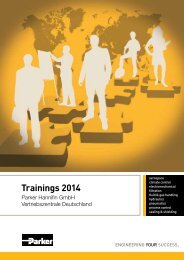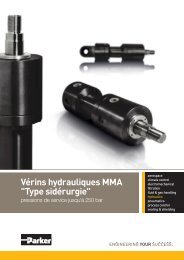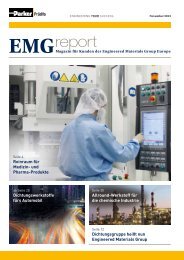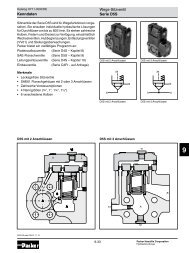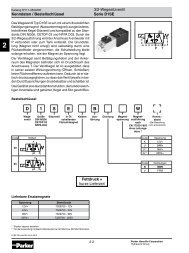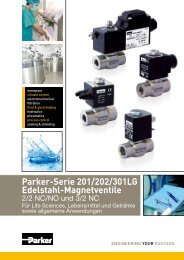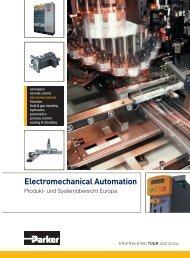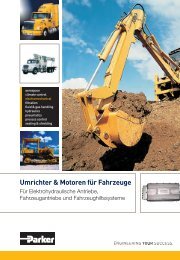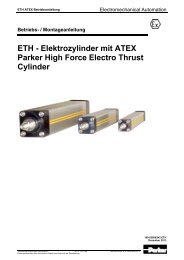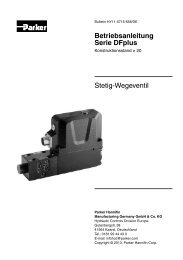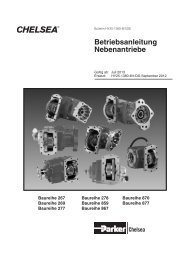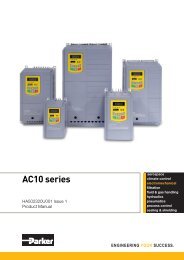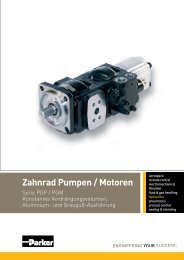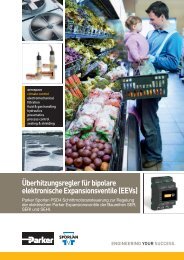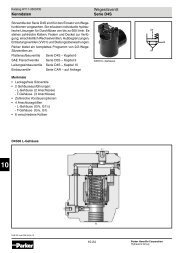L50 Injection Lubricator - Parker
L50 Injection Lubricator - Parker
L50 Injection Lubricator - Parker
Create successful ePaper yourself
Turn your PDF publications into a flip-book with our unique Google optimized e-Paper software.
Mist <strong>Lubricator</strong> & Particulate Filters Series 1M301<br />
Service Kits - <strong>Lubricator</strong><br />
Kit# Description<br />
PS420 Polycarbonate Bowl with Manual Drain - consists of items:<br />
18 (open bottom), 15, 16 & 17<br />
PS421 Polycarbonate Bowl without Drain - consists of items:<br />
18 (closed bottom) & 15<br />
PS740 Drip Control (Polycarbonate)<br />
PS740N Drip Control (Nylon)<br />
Parts Identification List - <strong>Lubricator</strong><br />
Item# Description Item# Description<br />
1 Knob 10 Ball, Check<br />
2 Drip Control Body 11 Spring<br />
3 Needle 12 Ball, Check<br />
4 O-ring 13 Body<br />
5 Drip Tube 14 Tube<br />
6 Seal Plate 15 O-ring (Body to Bowl)<br />
7 O-ring 16 Twist Drain<br />
8 By-pass Plate 17 O-ring (Drain)<br />
9 By-pass 18 Bowl<br />
Particulate Filter (Figure 2)<br />
Description<br />
These air line filters are heavy-duty units used to remove airborne<br />
impurities from air supply lines by means of centrifugal force and filter<br />
element. Units are equipped with vane-type deflectors and drain valves.<br />
Deflector plate creates swirling action to the air stream assuring<br />
entrainments separation at all flow rates. Filter element with extra large<br />
surface assures fine filtration with low pressure drop. Turn manual drain<br />
counterclockwise to open and clockwise to close.<br />
Installation of Filter<br />
1. Filter should be installed with reasonable accessibility for service<br />
whenever possible - repair service kits are available. Keep pipe and<br />
tubing lengths to a minimum with inside clean and free of dirt and<br />
chips. Pipe joint compounds should be used sparingly and applied<br />
only to the male pipe - never into the female port. Do not use PTFE<br />
tape to seal pipe joints - pieces have a tendency to break off and<br />
lodge inside the unit, possibly causing malfunction.<br />
2. Install unit so that air flow is in the direction of arrow. Installation<br />
must be upstream of and close to devices it is to service (valve,<br />
cylinder, tool, etc.). Position unit vertically with the bowl drain<br />
mechanism at the bottom. Free moisture will thus drain into the<br />
sump (“quiet zone”) at the bottom of the bowl.<br />
Operation of the Filter<br />
1. Both free moisture and solids are removed automatically by<br />
the filter.<br />
2. Manual drain filters must be drained regularly before the separated<br />
moisture and oil reaches the bottom of the element holder. Automatic<br />
drain models (pulse drain) will collect and dump liquids automatically.<br />
They are actuated when a pressure drop occurs within the filter.<br />
3. The filter element should be removed and replaced when the<br />
pressure differential across the filter exceeds 70 kPa (10 psig, 0.7<br />
bar).<br />
Service<br />
! Caution: SHUT OFF AIR SUPPLY and exhaust the primary and<br />
secondary pressure before dis-assembling unit. (Units may be<br />
serviced without removing them from the air line.)<br />
Servicing Filter Element<br />
1. Unscrew threaded bowl and element holder. Then remove filter<br />
element, deflector, and gaskets.<br />
2. Clean all internal parts, bowl, and body before re-assembling unit.<br />
See Polycarbonate bowl cleaning section.<br />
3. Install deflector, filter element, and gaskets.<br />
4. Attach element holder. Torque from 0.9 to 1.4 Nm (8 to 12 in-lbs).<br />
5. To assist with retaining bowl’s o-ring while installing bowl, lubricate<br />
the o-ring (with a mineral based oil or grease). Then place on<br />
the bowl.<br />
6. Screw bowl into the body until it is stopped by body; then back off<br />
bowl 1/8 turn.<br />
7. Apply pressure to the system and check for leaks. If leaks occur,<br />
shut off the air supply, de-pressurize the system and make necessary<br />
adjustments to eliminate leakage.<br />
If you have questions concerning how to service this unit, contact your<br />
local dealer or your customer service representative.<br />
Service Kits- Filter<br />
Kit# Description<br />
PS404 Polycarbonate Bowl with Manual Drain - consists of items:<br />
19, 24, 26 & 27<br />
PS408 Polycarbonate Bowl with Automatic Drain - consists of<br />
items: 19, 24, 26, 28, 29, 30 & 31<br />
PS447B Metal Bowl with Manual Drain - consists of items:<br />
19, 24, 26 & 27<br />
PS451 Metal Bowl with Automatic Drain - consists of items:<br />
19, 24, 26, 28, 29, 30 & 31<br />
PS403 5 Micrometer Element Kit - consists of items: 20, 21 & 24<br />
PS407 5 Micrometer Element Cartridge Kit - consists of items:<br />
20, 21, 22, 23 & 24<br />
PS401 40 Micrometer Element Kit - consists of items: 20, 21 & 24<br />
Parts Identification List - Filter Units<br />
Item# Description Item# Description<br />
19 Bowl 26 O-ring (drain to bowl)<br />
20 Gasket 27 Manual Drain (twist style)<br />
21 Filter Element 28 O-ring - pulse drain<br />
22 Filter Holder 29 Drain (body of pulse<br />
23 Deflector drain shown)<br />
24 O-ring (body to bowl) 30 Diaphragm<br />
25 Body 31 Pin<br />
Safety: Transparent Bowls<br />
1<br />
3<br />
4<br />
2<br />
5<br />
6<br />
7<br />
8<br />
9<br />
! Caution<br />
Polycarbonate bowls, being transparent and tough, are ideal for use with Filters and<br />
<strong>Lubricator</strong>s. They are suitable for use in normal industrial environments, but should<br />
not be located in areas where they could be subjected to direct sunlight, an impact<br />
blow, or temperatures outside of the rated range. As with most plastics, some<br />
chemicals can cause damage. Polycarbonate bowls should not be exposed to<br />
chlorinated hydro-carbons, ketones, esters, and certain alcohols. They should not be<br />
used in air systems where compressors are lubricated with fire-resistant fluids such<br />
as phosphate ester and di-ester types.<br />
Metal bowls are recommended where ambient and/or media conditions are not<br />
compatible with Polycarbonate bowls. Metal bowls resist the action of most solvents,<br />
but should not be used where strong acids or bases are present or in salt laden<br />
atmospheres. Consult the factory for specific recommendations where these<br />
conditions exist.<br />
TO CLEAN POLYCARBONATE BOWLS, USE MILD SOAP AND WATER ONLY! DO<br />
NOT use cleansing agents such as acetone, benzene, carbon tetrachloride, gasoline,<br />
toluene, etc., which are damaging to this plastic.<br />
Metal bowls are recommended where ambient and/or media conditions are not<br />
compatible with polycarbonate bowls. If you have questions regarding bowl<br />
application, contact your customer service representative.<br />
WARNING<br />
To avoid Polycarbonate bowl rupture that can cause personal injury or property<br />
damage, do not exceed bowl pressure or temperature ratings. Polycarbonate<br />
bowls have a 1030 kPa (150 psig) pressure rating and a maximum temperature<br />
rating of 52°C (125°F).<br />
10<br />
11<br />
!<br />
25<br />
24<br />
20<br />
23<br />
22<br />
TORQUE:<br />
8 - 12 in-lbs<br />
21<br />
15<br />
12<br />
19<br />
13<br />
Torque Bowl to<br />
26<br />
bottom stop, then<br />
back off Bowl 22<br />
to 45<br />
27<br />
TORQUE:<br />
finger tight<br />
14<br />
TORQUE:<br />
1 - 3 in-lbs<br />
18<br />
Torque Bowl<br />
to bottom stop,<br />
17<br />
29<br />
26<br />
30<br />
31<br />
then back off<br />
Bowl 22º to 45º<br />
16<br />
TORQUE:<br />
finger tight<br />
28<br />
Figure 1: Mist <strong>Lubricator</strong> Figure 2: Particulate Filter<br />
20



